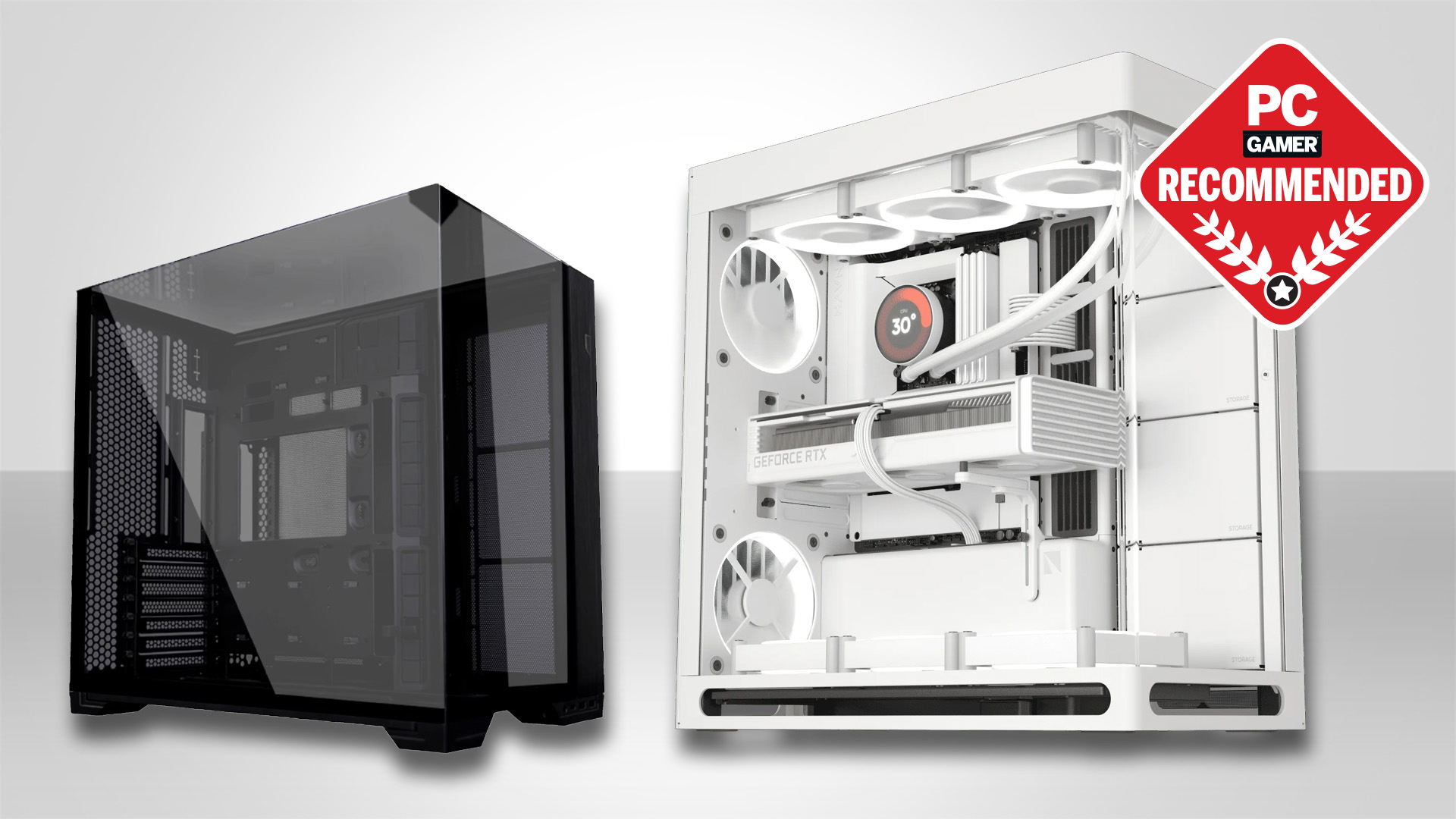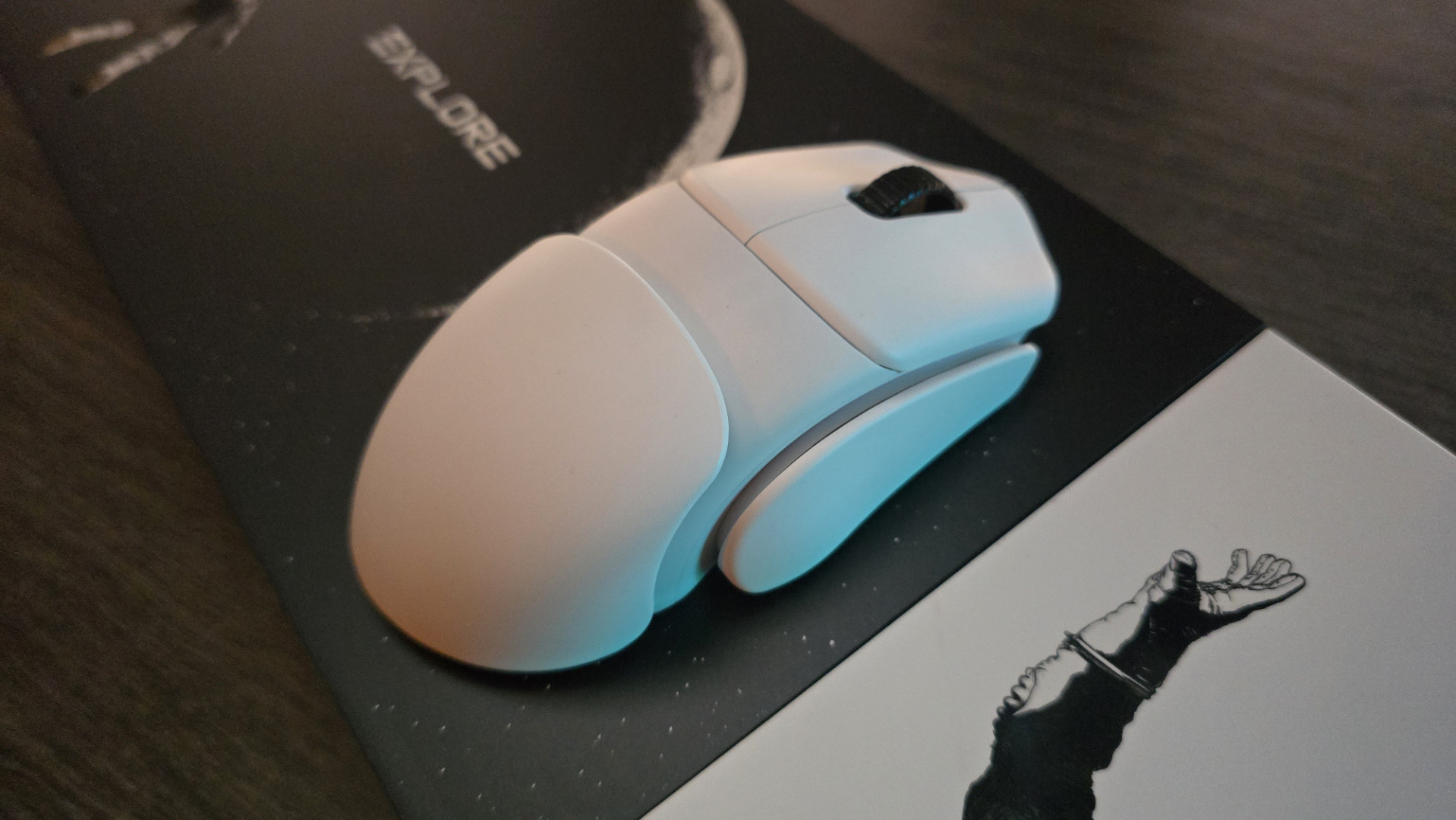Valve announces the Steam Frame: 'a new way to play your entire Steam library'
Wireless connectivity, improved optics, new controllers and a chip all of its own, the Steam Frame looks to be worth the wait.
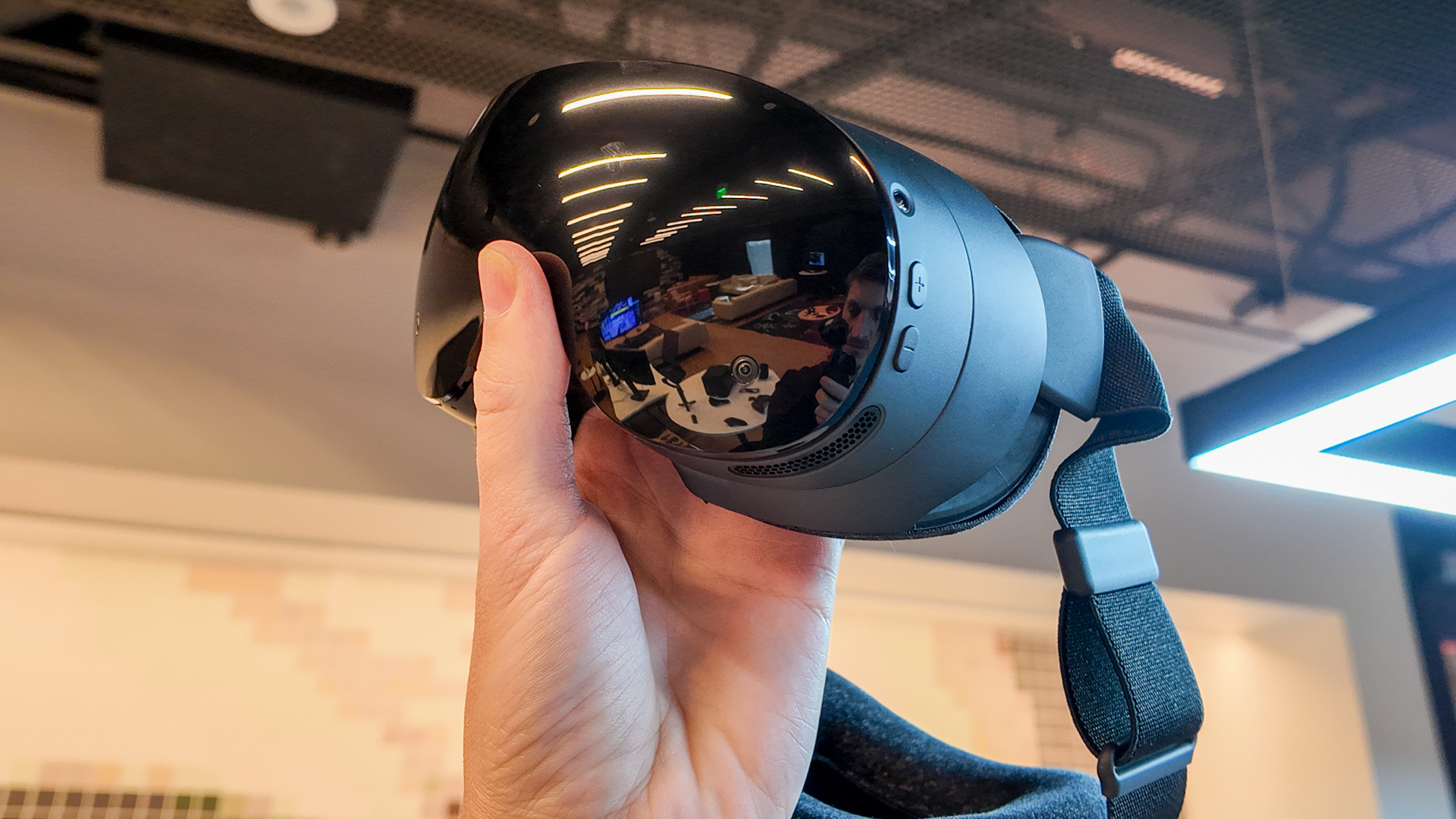
Valve has announced a brand new VR headset. It's called the Steam Frame, and it's set to launch next year. While pricing is not yet confirmed, I've been to Valve HQ to try it out and get all the details. This isn't the Valve Index 2, it's something quite different, but it should still appeal to hardcore VR users and new users alike.
The Steam Frame is a standalone VR headset. It doesn't require a PC in order to play games or watch videos in VR. It doesn't need base stations or a cable, either. It's powered by SteamOS, Valve's own Linux distro used on the Steam Deck, and an Arm chip. So, what makes this a PCVR headset again?
"We see Steam Frame as a streaming first headset," Lawrence Yang, a designer at Valve, tells me.
Streaming in this context does not refer to cloud streaming or showcasing your skills on Twitch. Rather streaming means playing a game on a gaming PC and streaming it over to the Steam Frame via a wireless connection. So, you're streaming the game from one PC to another PC on your head, without using any cables.

The Steam Frame includes a wireless adapter that plugs in via USB to a host PC, which can be any PC capable of running Steam and playing VR games. This wireless adapter beams the game over a dedicated 6 GHz connection to the Steam Frame. Essentially, Valve intends for players to use the Steam Frame in the traditional sense of tethering to a gaming PC—just without the physical tether.
- I've tried Valve's new VR headset: here's my Steam Frame hands-on.
The Arm processor in the headset unlocks new capabilities, however. The Steam Frame is perfectly capable of running games all on its own. It uses clever software to play games developed for Windows and x86 on its Linux and Arm stack. It also natively supports games programmed for Arm, which many VR titles are designed for these days.
We see it just as a new way to play your entire Steam library.
Lawrence Yang, Valve
So, it supports a bit of everything: standalone, PCVR, Linux, Windows, Arm, x86… though a user shouldn't have to be conscious of many, if any, of these technical divisions. You put the Steam Frame on, choose a game from your Steam library, VR or no, and play. The software takes care of the translation from one operating system or architecture to another—I'll explain those later.
Keep up to date with the most important stories and the best deals, as picked by the PC Gamer team.

With new hardware, software, and much expanded capabilities, Valve is keen to point out that this is not the Valve Index 2. Hence the name change.
"So Steam Frame, I would say, represents a fundamental shift in the way that we look at VR," says Yang.
"Rather than being a PC VR accessory to play your PCVR games, we see it just as a new way to play your entire Steam library, whether it's VR or non-VR titles."
I realise some people have been waiting for years for this announcement, pawing over every scrap of information in some patent filing or trademark. Those that did may recognise parts of the confirmed Steam Frame from the leaks before its announcement. Yet there's a lot of new stuff to dig into and plenty of new and unexpected features. So let's get into the juicier details.
Steam Frame: specs
| Header Cell - Column 0 | Steam Frame | Quest 3 |
|---|---|---|
LCD screens | Two | Two |
Resolution (per-eye) | 2160 x 2160 | 2,064 × 2,208 |
Refresh rate (Hz) | 72, 90, 120, 144 (experimental) | 72, 90, 120 |
Optics | Pancake | Pancake |
IPD adjustment | Variable with dial | Variable with dial |
Field of view (horizontal) | Up to 110 degrees | 110 degrees |
Field of view (vertical) | TBC | 96 degrees |
SoC | Qualcomm Snapdragon 8 Gen 3 (SM8650) | Qualcomm Snapdragon XR2 Gen 2 |
RAM | 16 GB LPDDR5 | 8 GB LPDDR5 |
Storage | 256 GB / 1 TB | 128 GB (discontinued) / 512 GB |
Battery | 21.6 Wh | 19.44 Wh |
Passthrough | Mono | Colour |
Cameras | 6 total (4x monochrome computer vision tracking exterior, 2x eye tracking interior) | 6 total (2x RGB passthrough, 4x IR) |
Speakers | Twin-driver (two per side) stereo speakers, integrated into strap | Stereo speakers, integrated into strap |
Connectivity | Wi-Fi 7 2x2 | Wi-Fi 6E |
Controller | 2x Steam Frame Controller | 2x Meta Quest Touch |
Controller battery | 1x AA per controller | 1x AA per controller |
OS | SteamOS (Linux) | Meta Horizon OS (Android) |
Weight (grams) | 435 (190 for core module alone) | 515 (461 without strap) |
Price | TBC | 512 GB: $500 |
Valve hasn't confirmed pricing for the Steam Frame, nor the exact release date. What we do know is the headset will launch sometime in 2026, alongside the Steam Machine and Steam Controller.
The two storage options offer some flexibility on price. The 256 GB model appears very much geared towards streaming and PCVR use and should be notably cheaper than the 1 TB model, which looks set for standalone use.
Steam Frame: optics
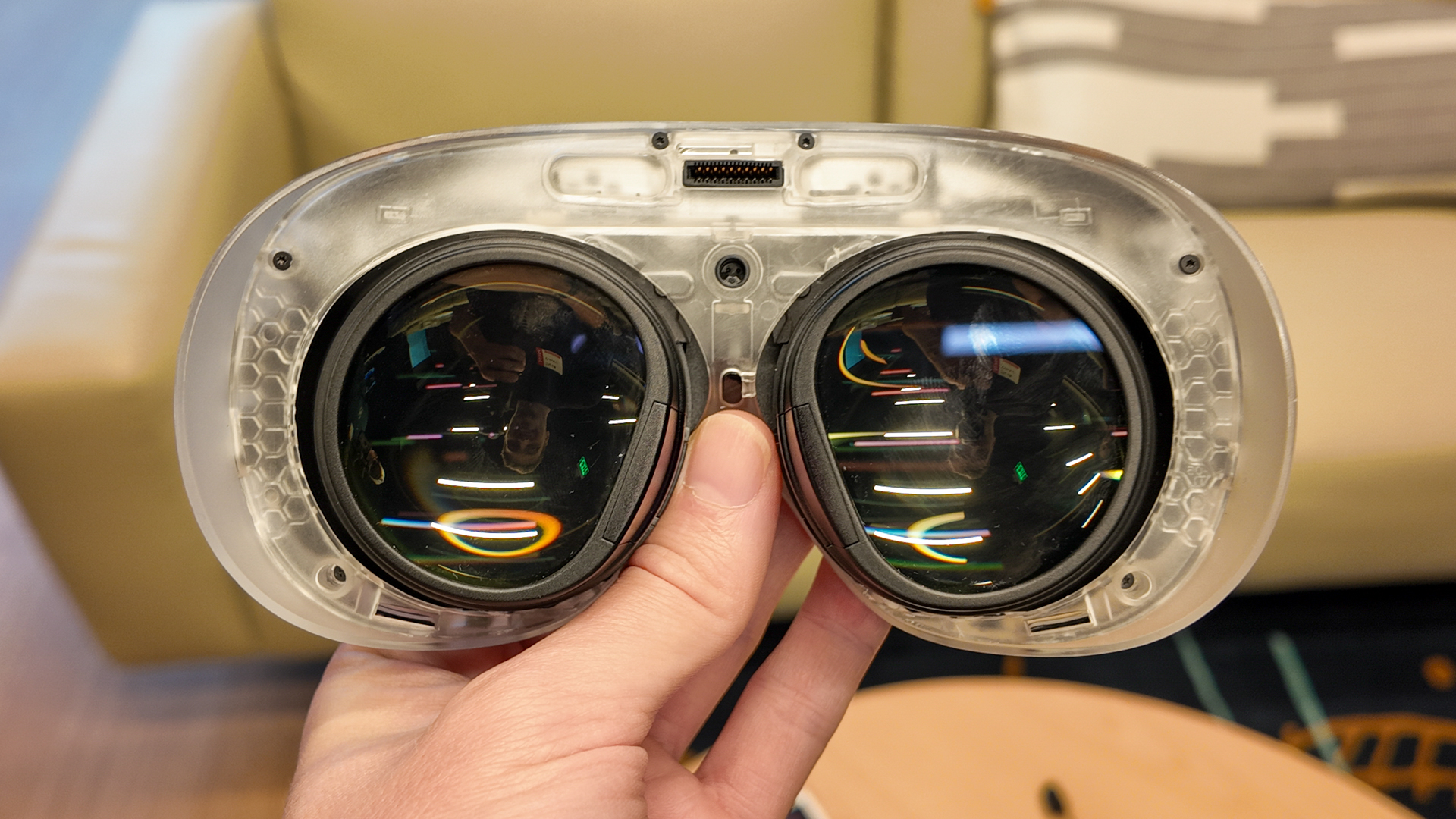
The Steam Frame uses a brand new optics system and higher resolution LCD screens than the Valve Index. Following in the footsteps of other modern VR headsets, Valve is using pancake lenses to dramatically reduce the size of the optics and increase edge-to-edge sharpness. Though I'm told it really came about the other way round.
"So you get a lot more what we call aberration correction. You can get really nice, sharp imagery," Joshua Hudman, a hardware engineer at Valve, says.
"And then it turns out that, because it's in what we call double pass, it means you can squish the optical system even more. So it really is a nice solution for VR."
The headset offers a clear, undistorted image from the centre to the furthest edges. These improvements to the eye box (the area of view that's comfortable and clear for a user) make a big difference to visual fidelity and clarity. If memory serves me well (I loaded up my Quest 3 again just before heading out to Valve HQ), it looks similar to Meta's top consumer headset in this regard.
Part of that is the screens Valve is using with the Steam Frame: two LCD panels, 2160 x 2160 per eye. That's pretty similar to the Quest 3 and a huge improvement over the Valve Index at a mere 1440 x 1600 per eye. As far as I'm aware, the Steam Frame uses the same RGB subpixel layout, too, in lieu of an OLED or Micro-OLED panel.
The interpupillary distance (IPD), to account for the distance between a user's pupils, can be adjusted via a scrolling wheel on the top of the headset. I didn't catch the exact minimum and maximum IPD distance available during my time with the headset but it offers a decent range.
Steam Frame: design
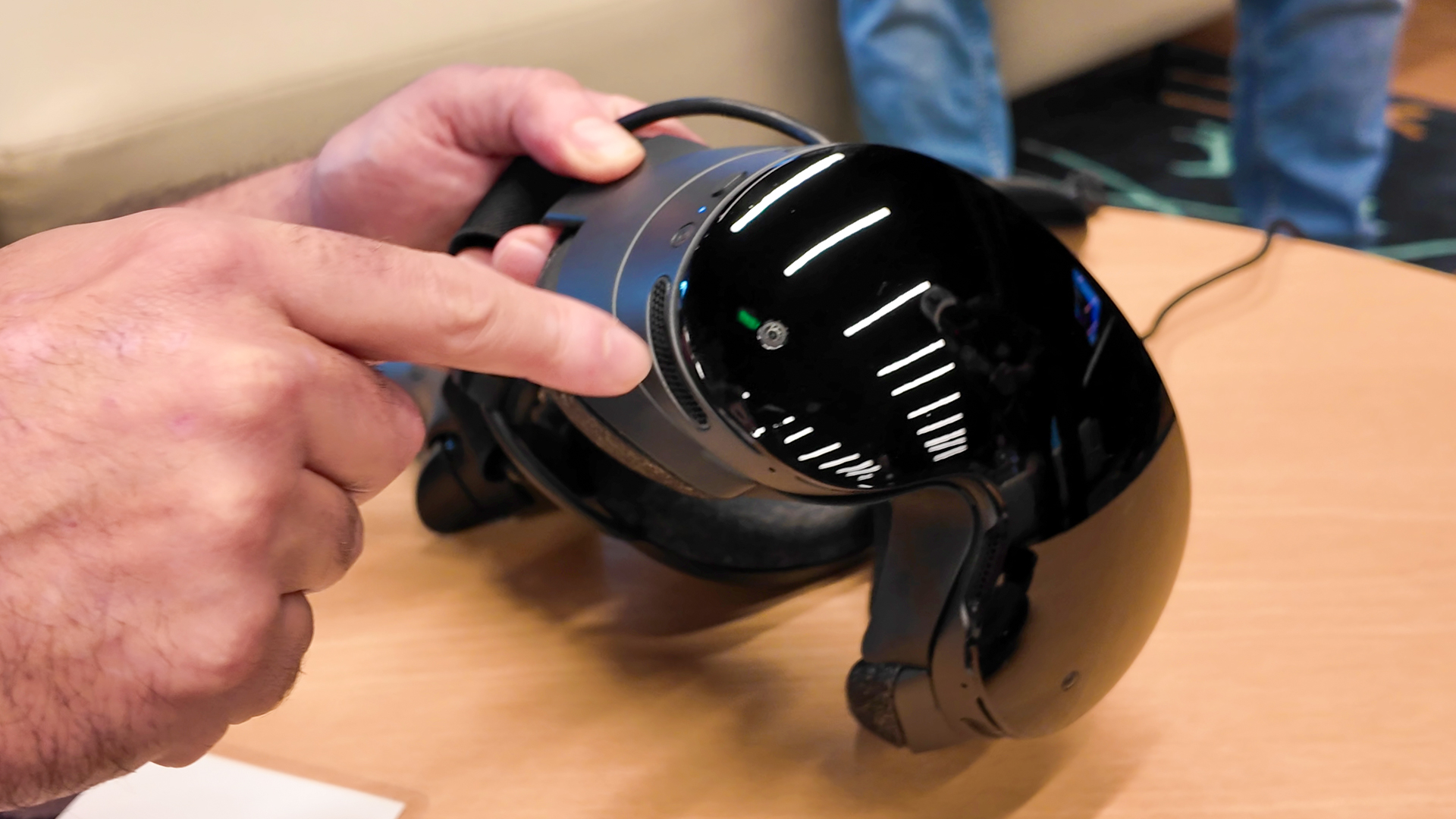
The Steam Frame is a diminutive device, much slimmer than the Valve Index. On the right-hand side of the headset there's a power button, which supports fast suspend and resume for quickly jumping back into your games, and an auxiliary button that controls the cameras or selecting options in the menu without the use of controllers. On the left-hand side sits the volume controls.
Glasses wearers can breathe a sigh of relief as there's a spacer to extend the space behind the lenses to accommodate for glasses included in the box. Valve also tells me it's investigating prescription inserts for those who prefer to have their headset ready to go without wearing anything else.
We put an enormous amount of effort into making that as lightweight as possible.
Jeremy Selan, Valve
Valve intends for the Steam Frame to be modular. In this vein, it's included a few neat ways to accommodate mods, accessories, and updates.
The core module, as Valve calls it, houses the processor, optics, cameras, and necessary cooling. This can be removed from the strap—it simply pops out. It's surprisingly lightweight in hand, weighing only 190 grams. It's also very slim. Even with the Qualcomm Snapdragon 8 Gen 3 (SM8650) system-on-chip sitting between the pancake lenses and face plate, and cooling, and cameras, it extends, at a guess, 2–3 inches from the face.
You'll notice a transparent core module in some of my pictures here. That's just a prototype intended to show off the internals on the Steam Frame. It is not going to be available to purchase. I'm sorta into it, though.
The strap contains the battery, speaker system, microSD card slot, and a USB 2.0 Type-C connector, which lets you charge the device via an outlet or power bank as you play.
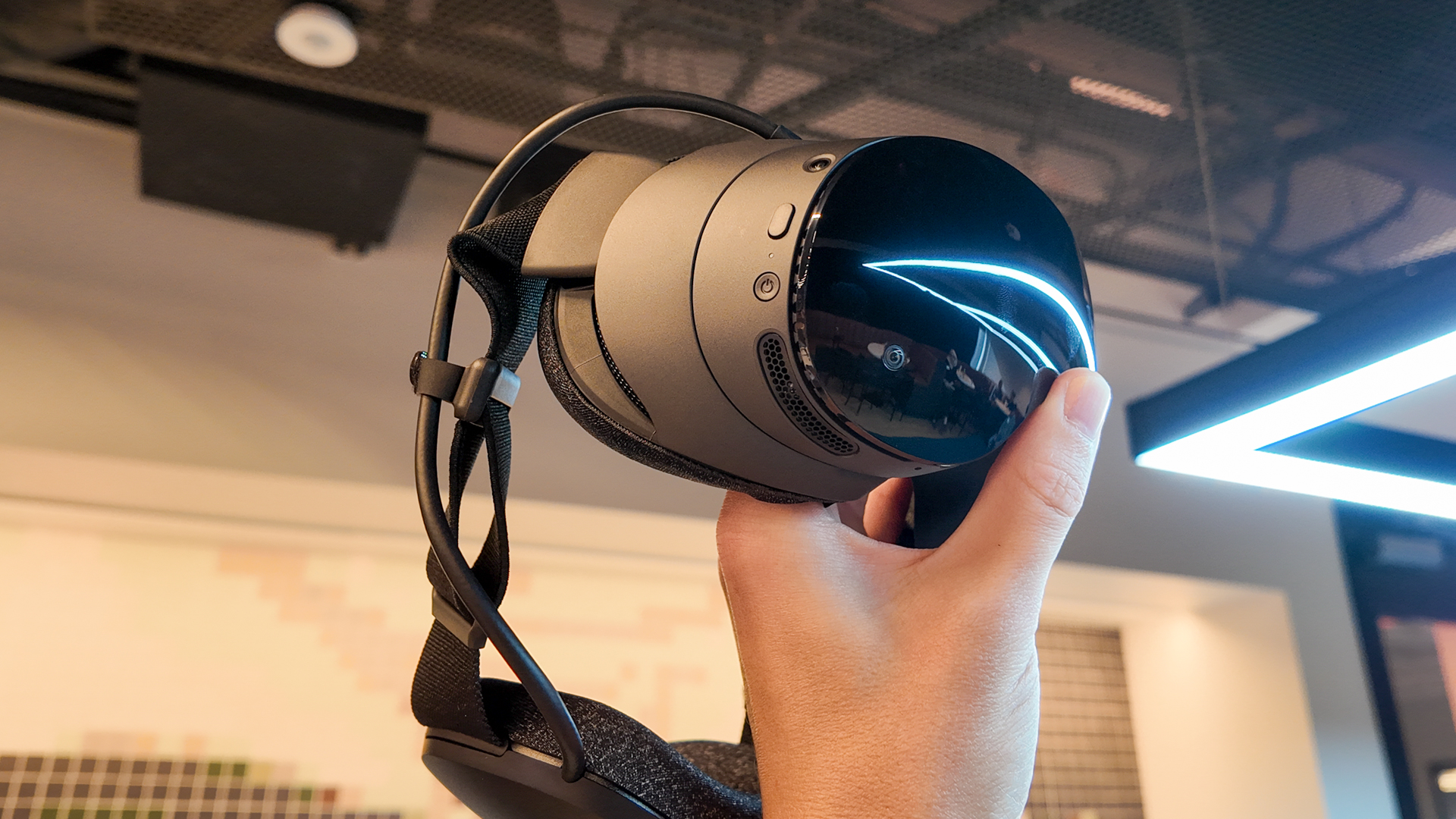
By placing the battery on the rear of the device, it counteracts the weight of the core module and keeps the headset nicely balanced on your head. I didn't feel much pressure on the front of my face wearing it, though I didn't wear the Steam Frame for long enough to truly test the ergonomics of it.
"We put an enormous amount of effort into making that as lightweight as possible. And then furthermore, the rear is balanced as well. So because we've split the weight between the front and the rear, and because this sits so close to your face, it's one of the most comfortable VR headsets we've ever used, and we're very proud of that," Jeremy Selan, an engineer at Valve, says.
The Steam Frame stayed rather cool on my face during my time with it, which I'm told is part of the reason for opting for the Snapdragon chip used here. It demands very little cooling, reducing weight and allowing for easier heat dissipation, and it supports plenty of inputs (required for the six cameras included on the headset).
The strap connects to the core module via a proprietary connector to keep it powered on, playing audio, and loaded with games via any onboard microSD storage.
Though the idea of having two parts being you can replace the strap easily, perhaps for one with a larger battery or simply because it's broken, without throwing away the entire unit. If you only need to replace the padding, those come away from the strap separately.
The strap that ships with the headset only includes two adjustable lengths to circumvent your head on either side. There's no top support as standard. This is bundled as an optional extra alongside extra straps for the controllers. The repackaging of seemingly affordable extras as an optional package gives me hope that Valve is going for affordability here by cutting out unnecessary costs and reducing the price. Though I could be wrong.
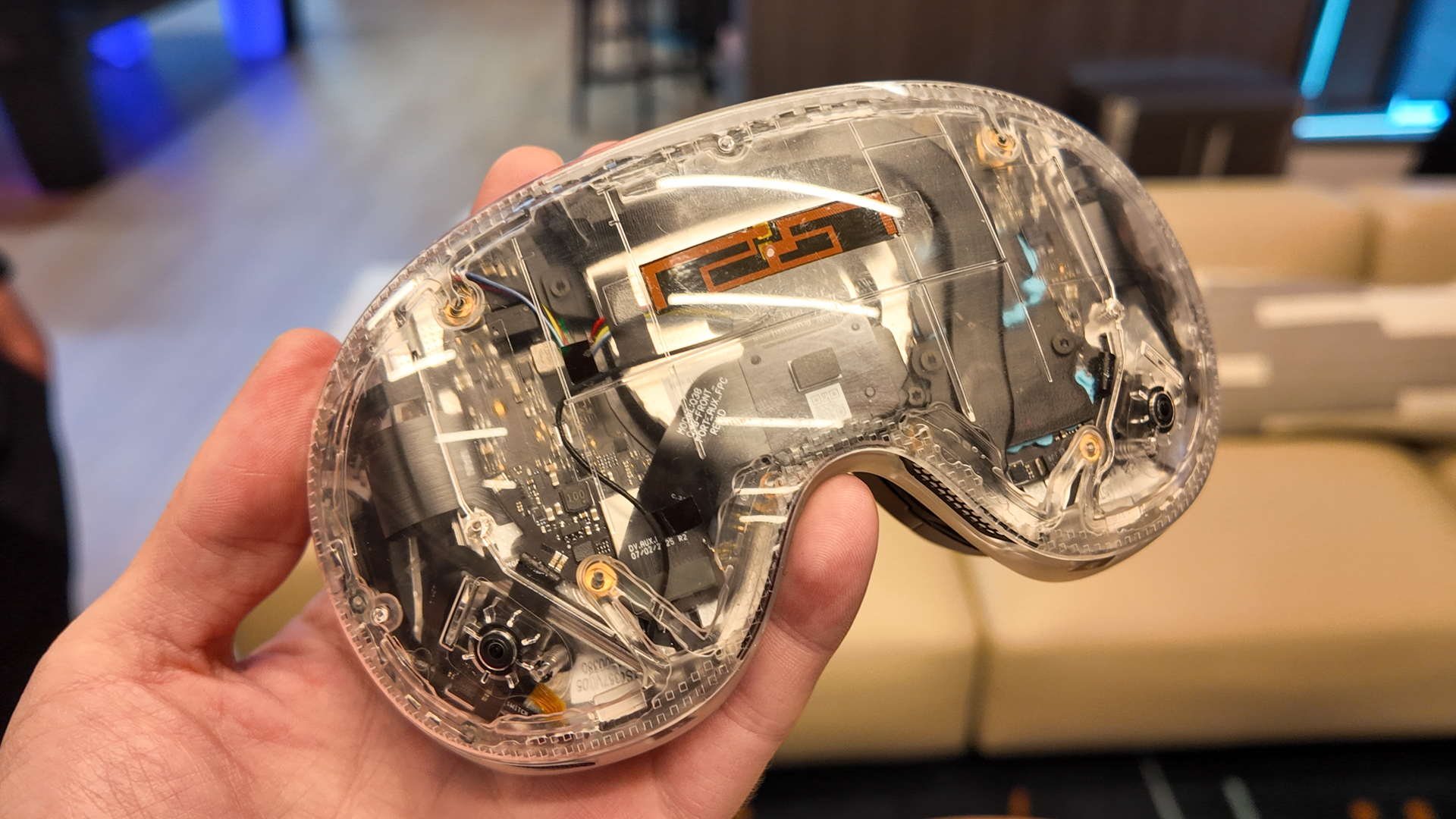
Back to the modularity a moment, there's also an unused connector on the front of the core module, above the cutout for your nose. This is a PCIe 4.0 interface, which can also be used for 2.5 Gbps camera feeds, opening it up for use by a variety of things. While Valve is not announcing any accessories to go with this right now or any alternate straps, it is happy to talk about the potential this modular approach offers in general.
"The interesting thing about the modular architecture is we know there's a lot of strong opinions and diversity about where people want the battery, for example, what type of audio they want, and there's just a lot of perspectives on that," Selan says.
"And we agree, which is why we're not announcing anything today, but you could imagine that the same headset with this type of core module, you could have alternative versions of the head strap that could offer different features to different groups of people."
Steam Frame: processor

The Steam Frame contains a Qualcomm Snapdragon 8 Gen 3 (SM8650) processor. This is an eight-core chip consisting of:
- 1 Prime core (up to 3.4 GHz)
- 5 Performance cores (up to 3.2 GHz)
- 2 Efficiency cores (up to 2.3 GHz)
To put this chip's performance into perspective: it's a 4 nm processor that was first launched in 2023, but was the go-to for flagship phones through 2024, such as the Asus ROG Phone 8 Pro. It's not quite at the cutting edge for mobile chips. That'd be the Snapdragon 8 Elite Gen 5. Neither is it the chip intended solely for handheld gaming, the Snapdragon G3 Gen 3. Though it is pretty up-to-date.
It works to Valve's benefit in a few ways, anyways. It supports a large number of inputs, which is beneficial for a VR headset requiring lots of cameras, and includes good connectivity options, including Wi-Fi 7. It also has low demands for cooling, which is beneficial for a chip that's sitting quite so close to your forehead at all times.
Steam Frame: battery
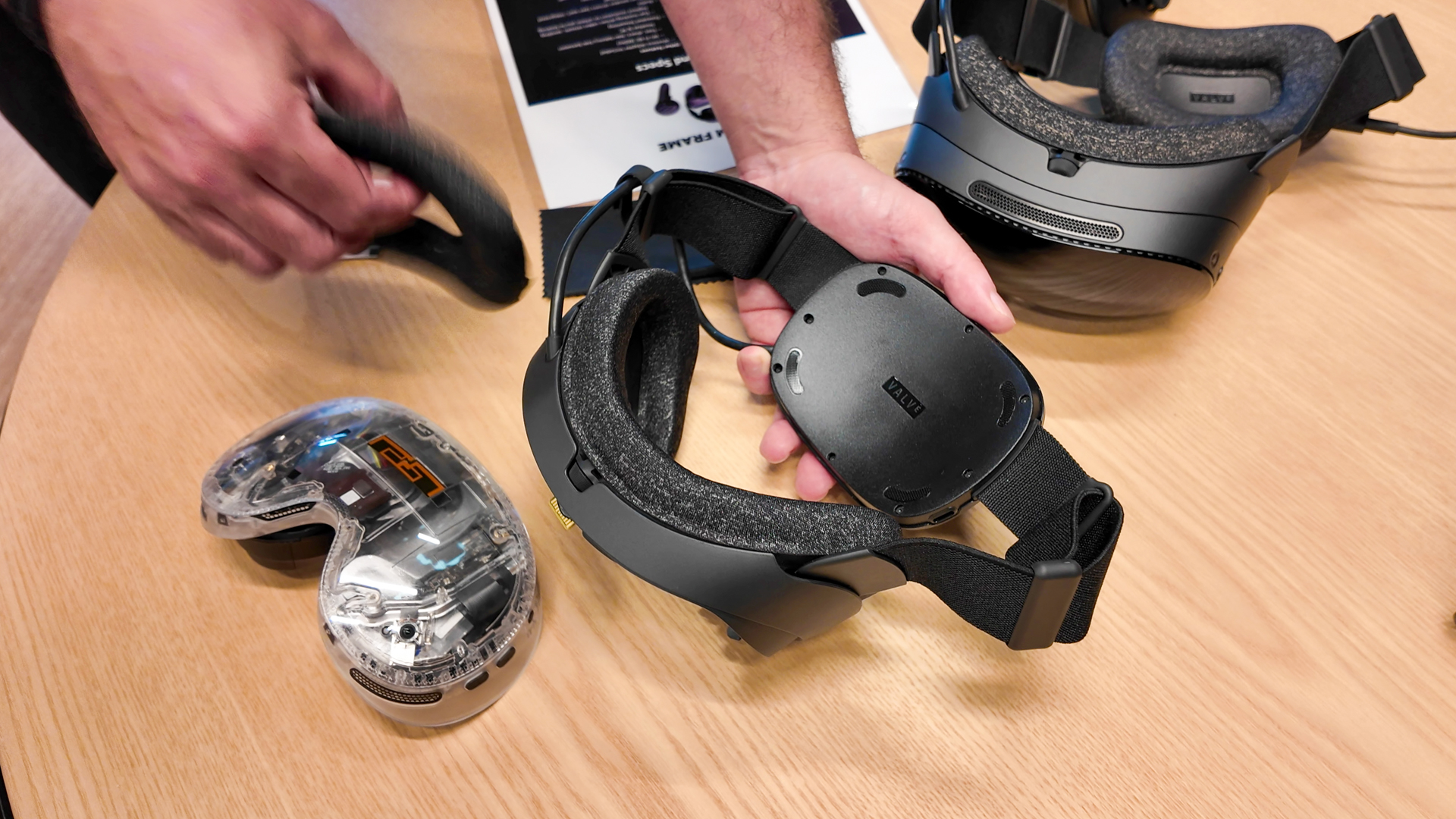
The battery included on the Steam Frame is a 21 Wh model. The Snapdragon system-on-chip gobbles up around 20 W at full power—that's how much it'll likely use while playing a game locally in standalone mode. From this, we can expect around an hour of playtime without additional charge.
If you're only streaming on the device—that is, running a game on your PC and beaming it to the Steam Frame using the supplied wireless adapter—the Snapdragon processor requires very little power for this purpose. Potentially as little as five or six watts, I'm told, which even if you're conservative about battery life, massively increases the available playtime to multiple hours.
It's possible to improve battery life with an external power bank connected via the USB 2.0 port on the rear of the strap.
"A lot of us have extra power bricks we just slide in our pocket, and it gives us lots of hours to play at extremely high power values, and it just plugs in and goes right into your pocket," Clem Gallois says.
And the good news is that Valve has kept repairability in mind with the battery. I'm told that somebody certified to work with batteries could open the unit up and replace the cells if they knew what they were doing. Read: that's not Valve telling you to open the battery up and try it yourself. Don't do that.
Steam Frame: tracking

The Steam Frame's inside-out tracking, so named for using sensors on the headset to track a user's environment, is taken care of by four cameras on the exterior that are designed for computer vision tracking.
Outside-in tracking is not supported by the Steam Frame at this time. That means there is no support for the lighthouse tracking system used by the Valve Index. It's a win for the average gamer, though, as inside-out tracking is exponentially easier to set-up in a short period of time and a tight space.
Tracking in the dark won't be an issue for the Steam Frame. Selan tells me the four cameras on the device are good in low light conditions, but moreover, there are IR illuminators behind the face plate that allow for tracking in the dark.
"You can even use the passthrough in complete darkness and you sort of get a night vision view," Selan says.
But through using the Steam Frame's modular construction—that small port exposed on the front of the face plate—it could be possible to plug in an accessory that allows, for example, full-colour passthrough or another form of tracking support in future.
"We have an expansion port that allows for high speed camera information as well as for data, right? So you can imagine lots of interesting things you can do by plugging accessories into it," Selan says, adding that Valve is not announcing any accessories at this time.
Steam Frame: speakers

One of the best features of the Valve Index are its speakers, the so-called BMR (Balance Mode Radiator) were a novel approach to audio among VR headsets. These off-ear speaker units have not made a return for the Steam Frame, I'm afraid, though the integrated speakers on either side of the Frame's strap are a little unusual still.
There are two drivers per speaker unit on the Steam Frame, embedded into the strap. The reason for the dual drivers is due to the headset's tracking systems, and avoiding interference.
"I would say these are excellent speakers. There's actually dual drivers per side because of vibration cancelation," Selan says.
"We have four cameras on the exterior to do the computer vision tracking, but there's also an IMU that detects the motion, and when you do essentially loud, high fidelity audio that includes bass, for example, it can cause certain vibrations. And so this is a new speaker system, where there's two drivers per side that move in opposite directions, and that allows us to have audio we're very proud of that's sort of seamlessly integrated, but at the same time, doesn't compromise the tracking in any way."
I have no complaints with the speaker system from my time with the Steam Frame. Half-Life: Alyx comes through clear with an airy and open soundscape. I guess that's the benefit of speakers a distance away from your ears rather than in-ear buds.
Steam Frame: controllers
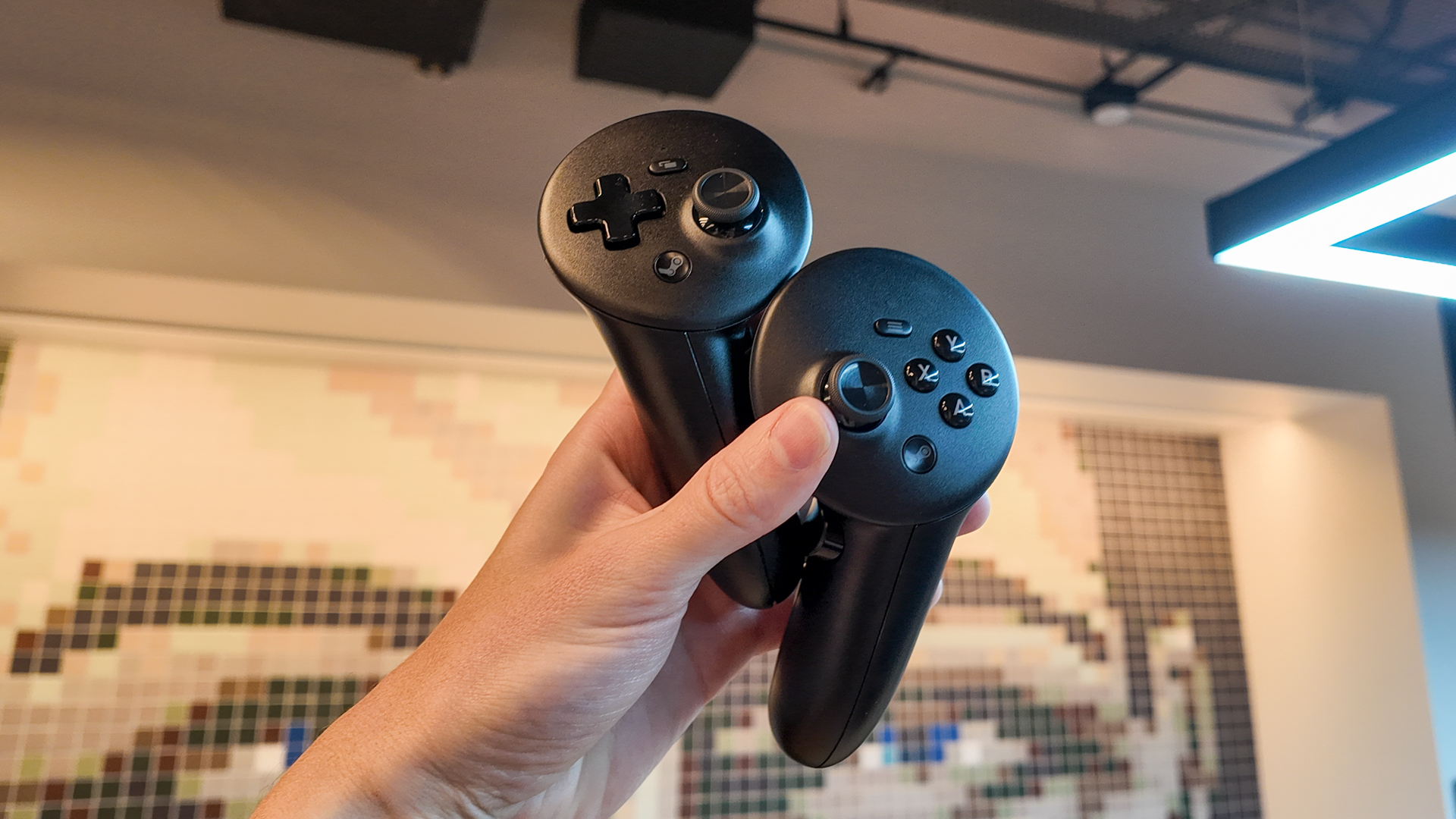
The Steam Frame comes with two brand new and aptly-named Steam Frame Controllers. Gone are the curvy controllers from the Valve Index, replaced by a design much more in line with other popular VR controllers, such as the Quest Touch.
The idea behind the controllers is to offer a way to interact with both VR games and non-VR games.
"This looks like a traditional game pad design split in two," Valve engineer Jeff Leinbaugh says.
The controllers have all the buttons required to play as if you're using a standard controller, including rear triggers and shoulder buttons. These maintain the same six degrees of freedom expected of any good VR controller, with a comfortable if quite minimal design.

"They do a lot of things but we think that all comes together quite nicely to make this something that will play all your games."
The controllers are tracked via the four cameras in the headset, and have 18 infrared LEDs located across the top and handle. They also contain an IMU, or inertial measurement unit, which Leinbaugh says is "critical for good tracking."
Only a single AA battery is required per controller, offering up 40 hours of battery life. Haptic feedback is included along with capacitive finger sensing on the buttons, grips, triggers, handle, and thumbsticks. This means it can track individual fingers to some degree, though it's notably less pronounced than the Index implementation.
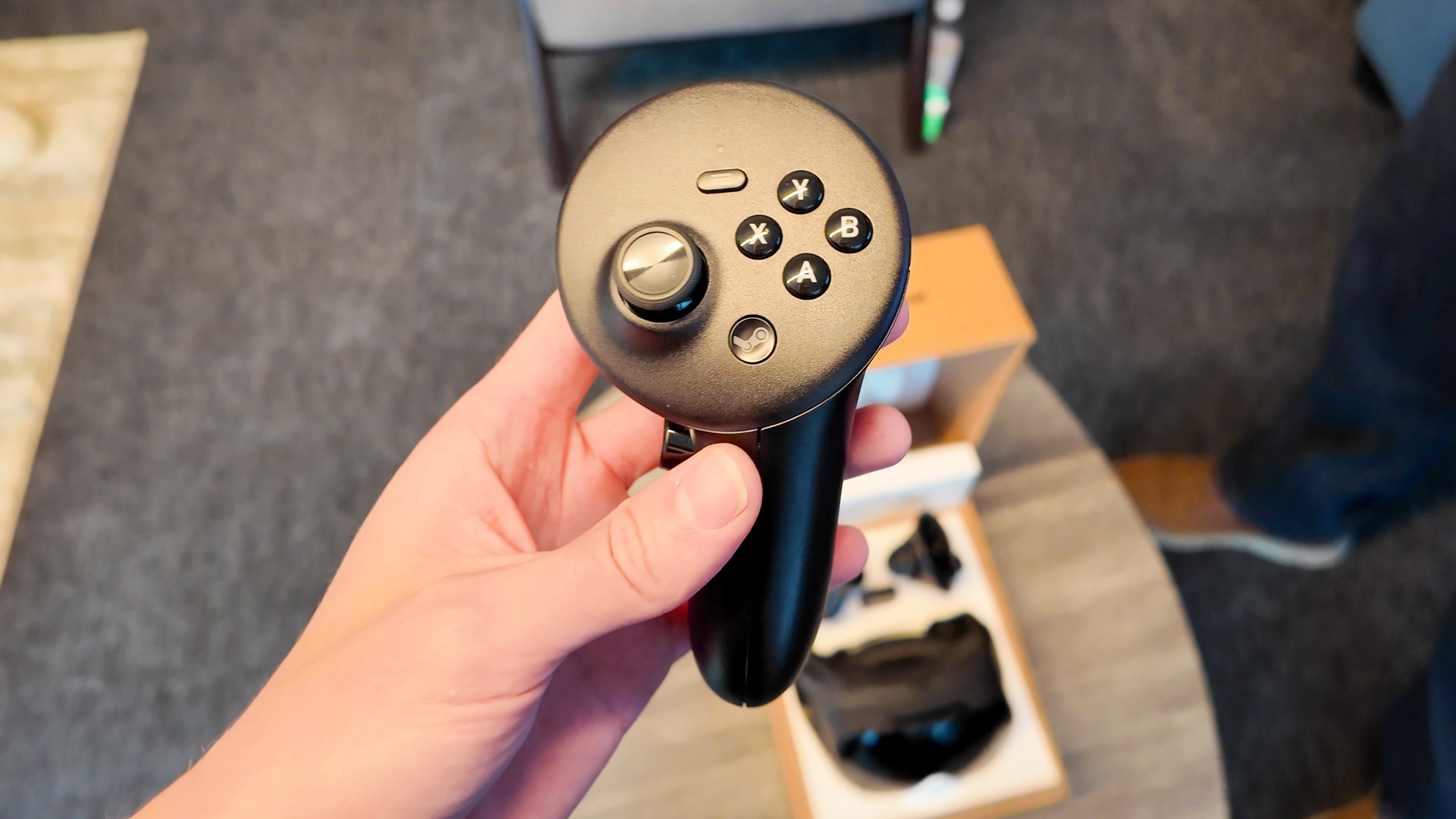

The analogue sticks are using tunnel magnetoresistance (TMR) sticks, which are similar to Hall effect in their use of magnetic force to measure stick movement with higher levels of accuracy and reliability than potentiometer sticks used almost exclusively until quite recently. TMR reduces the risk of stick drift to near zero and allows for a lower deadzone out of the box. Altogether, a good move, as TMR or Hall effect sticks were a notable omission from the Steam Deck (though easily modded in).
There's an optional ergonomic accessories kit for the Steam Frame that adds an extra strap for your head and a pair of straps, one for each controller. These added controller straps are reminiscent of those found on the Index and seem like a reasonable investment, if the price is right.
Steam Frame: storage

Valve is offering two options for storage: 256 GB and 1 TB.
The 256 GB model seems best for a user that primarily aims to stream games from their PC to the Steam Frame or wants to save some cash (how much to be determined). The 1 TB model appears best for users that wish to use the Steam Frame as a PC, or run games locally on the Arm chip inside.
There is also a microSD card slot for further expansion, which should be a fairly affordable way to bulk up the internal storage. Valve has confirmed that games should run just fine from a reasonably speedy microSD card, too. The Steam Frame will support microSD cards up to 2 TB using the SDXC format, same as the Steam Deck.
It's also possible to switch microSD cards between the Steam Deck, Steam Frame, and Steam Machine, carrying your pre-installed games across devices.
"There's a SD card slot. So you can take your catalog from your Steam Deck or from your Steam Machine, and they're fully interoperable, so you can plug it in here and just bring it along with you," Selan says.
Steam Frame: streaming with a PC

Using the Steam Frame alongside a gaming PC is the most likely use case for the new VR headset. Valve designed the headset with this intention, and for PCVR users, it's the same sort of experience as you're likely used to, only without any wires.
"We think of this as a streaming first device. So by that we mean we would expect most customers to have a PC or laptop, and then to stream that content from that to the Steam Frame," Selan says.
That's one of the tricks we have that allows the streaming experience to be really good
Jeremy Selan, Valve
The content available for streaming is any game or software available on Steam, including VR games and non-VR games. Valve makes a point of pushing the Steam Frame as a new way to enjoy games whether intended for VR or not, via a cinema-like viewing experience for 2D titles.
"You just browse your games, and sometimes you feel like a VR game. Sometimes you don't." Selan says.
Each Steam Frame includes a wireless adapter in the box. This is key to the wireless streaming experience. A USB 3.0 device that attaches to your gaming PC or laptop, it provides a dedicated 6 GHz connection direct to the Steam Frame that transfers the game visuals, audio, and data required to play.

This happens via a separate antenna on the Steam Frame to the one providing the headset's Wi-Fi 7 capability. This way, there's no need to balance bandwidth between game downloads, multiplayer traffic or streaming—the dedicated streaming antenna ensures the stream remains uninterrupted by whatever else the headset is doing. It's also a good way to bypass strict requirements on routers and network cards for users to get the full experience.
"What this means is that we have a very high speed, dedicated link that doesn't have to bounce around directly between your PC and the headset. And that's one of the tricks we have that allows the streaming experience to be really good," Selan says.
The connection has to offer low latency, or risk causing nausea, while still delivering the bandwidth required to run the Steam Frame's display. Valve has another trick to help with that, however.
Foveated streaming helps lower the bandwidth requirements by streaming only parts of the image in high resolution. Requiring the two eye tracking cameras within the device, foveated streaming dynamically adjusts the patch of high-quality streamed content based on where you're looking. Think of it like two magnifying glasses over the top of a low-resolution image. Your eyes move the magnifying glasses.
Essentially, the entire environment is rendered in you're actively looking at (directly in front of your fovea) will be streamed at maximum quality. Everything in your peripheral vision, or thereabouts, will be streamed at a lower quality. From what I can tell, this matches with a technique used on other VR headsets with eye tracking called quad views rendering, and Valve's approach sounds like practically the same thing, except for streaming.

The two eye tracking cameras have to adjust quickly to keep up with every glance and look, but I tried Half-Life: Alyx with a developer setting enabled that shows the eye tracking in action, and no matter how quickly I moved my eyeballs around, the tracking kept up.
"We find that even the most observant viewers, it's very, very hard to see what's happening and to tell that it is, in fact, not uncompressed," Selan says.
"So you could imagine that if that foveated area, say, represents 10% of the full field of view, it would actually be a 10x multiplication factor in bandwidth, in latency, in robustness... this is happening continuously behind the scenes. And most critically, the software developer, the partners who ship on Steam, don't have to do any work to take advantage of that."
That's the important bit: a game needn't be programmed to take advantage of foveated streaming, meaning there's no requirement for per-game support. Foveated rendering, however, does require per-game support, and there's only a little of that around today. Though, speaking to Valve, it sounds like both foveated rendering and foveated streaming can be employed at the same time in games that support the former.
With streaming requiring much lower power demands than rendering locally on the Steam Frame's Arm chip (Valve explains it's around 5–6 W to 20 W), battery life is extended significantly. That's hours playing games in virtual reality without a cable to drag you down, which honestly felt pretty great during my time with it. Night and day to the heavy, cumbersome cables-cum-trip hazards of older generation VR headsets.
Steam Frame: standalone
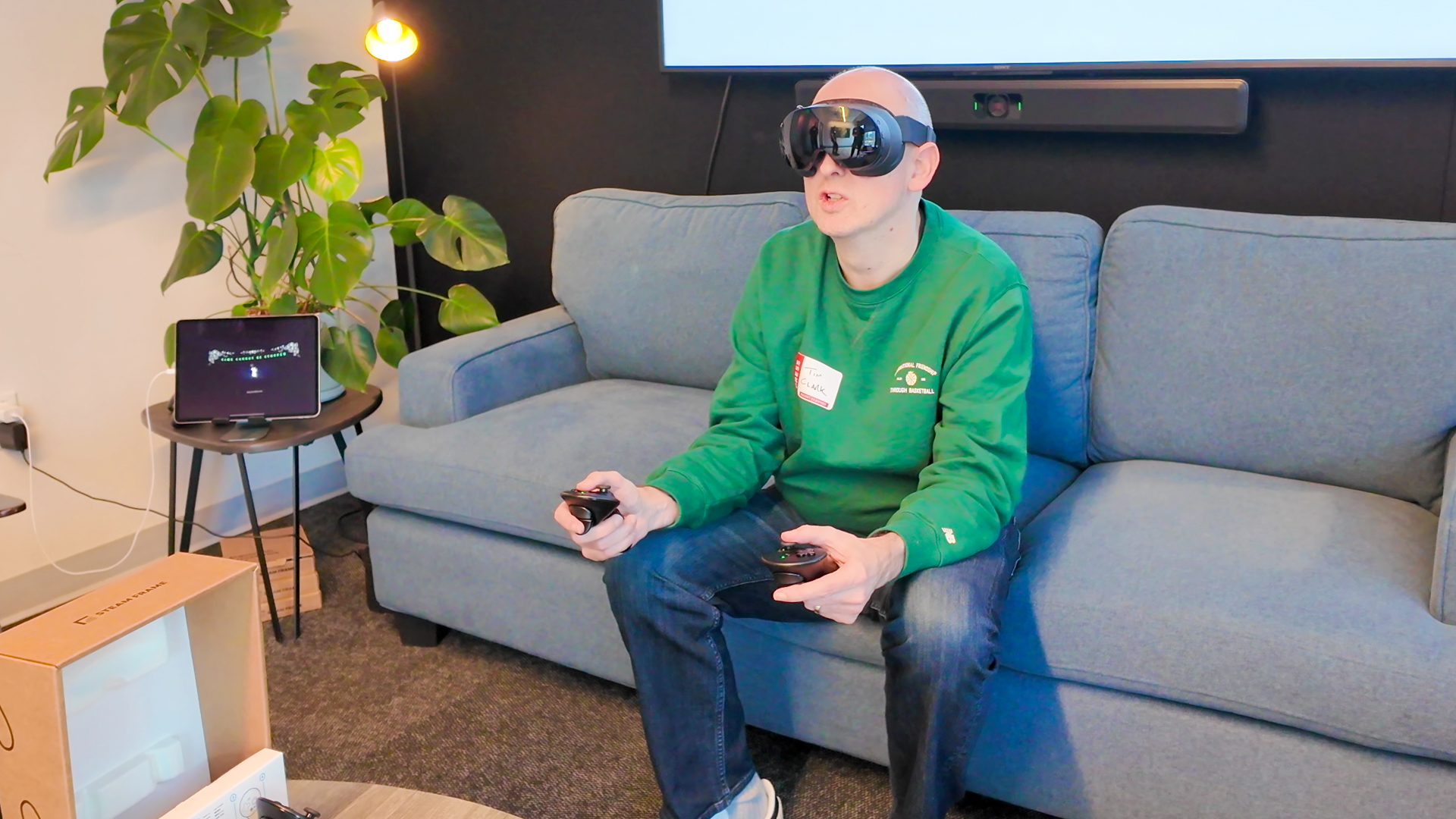
The Steam Frame is a standalone VR headset, which means it's a computer all of its own. Specifically, a computer powered by a Qualcomm Snapdragon 8 Gen 3 (SM8650) SoC, powered by an Arm architecture and Valve's own Linux-based operating system, SteamOS. This inevitably requires the release of SteamOS for Arm alongside the Steam Frame.
"This has 16 gigabytes of RAM, so if that itself can be an indicator for the types of games you'd expect to be able to run on this device," Selan says.
On the one hand, game support should be dramatically increased by Valve's adoption of an Arm processor. It opens the door to booting apk format files, which are used on Android devices powered by Arm chips.
This is especially important when you consider that VR game and app development has shifted focus largely to Android-based systems, including Meta's Horizon OS and Google's newly-released Android XR, and away from Windows-based PCs. It should be a fairly simply task for developers that have prioritised Meta's popular VR headsets to bring their games and applications to the Steam Frame, either via an apk sideloaded on the device or an actual listing on Steam.
"So for partners and developers who have developed applications for other mobile VR, they'll just work on this headset," Selan says. "We're trying to minimize the amount of friction. If you've ever heard of a Tilt Brush that was one of the classic, original VR apps, they have an application open brush. When they open sourced it, you can download today, the open, the tilt, brush apk from their website, side load it, which we're happy to let you do, and just double click it, and it runs."

When asked whether Steam would start to include games and applications for Arm devices in its library, Lawrence Yang's response was, "Absolutely, that'll be a new thing that Steam will do."
On the other hand, attempting to play VR games already available on Steam, largely programmed for x86 processors and Windows, on the Steam Frame's Arm processor and Linux-based operating system comes with its own challenges.
Valve has the Windows to Linux translation down pretty well these days with Proton. This being the secret sauce for the Steam Deck's success. However, Valve has had to introduce something new to convert the x86 code to Arm. For this task, it's using FEX.
FEX is an open source emulator for Arm systems. A translation layer, taking the scrambled code of x86 and turning it into legible code for Arm systems.
"One of the superpowers of SteamOS is that it decouples the games you're playing from the hardware you're running it on. And so we've introduced a new technology with this device called FEX, and it's now part of the Proton umbrella. And what FEX allows you to do is continue to run your x86 PC catalog on Arm," Selan says.

"So without that technology, Arm would have been much less of an interesting choice, because we very much want you to bring your catalog with you to this device. But now that we have FEX, you don't really have to think about that."
One of the special features of FEX is it enables Valve to forward API calls to the Steam Frame's Arm processor for supported APIs, such as Vulkan. This means games that use the Vulkan API don't require as much emulation as those that don't, which helps improve performance and compatibility.
Though compatibility is a consideration for FEX. Valve didn't want to put a number on the titles that will run via FEX, though it says it already exceeded its original targets for game support.
"We're actually already at the point now where we're trying games and just seeing if they run, and a lot of times they run, and it's very pleasantly surprising how well it's going already," Yang says.
This is a PC game made for x86 running on SteamOS on an Arm chip, and the average customer wouldn't have to worry about all that.
Jeremy Selan, Valve
There's also going to be a performance hit from using FEX, though how much so depends on the game and how much of it requires emulation. In some cases, such as when a game is running Vulkan, there might be a 10–20% performance hit, limited to CPU emulation. The GPU performance is more or less native. Though that's only Vulkan, which natively supports Arm. Other APIs won't be so lucky.
Nevertheless, Selan tells me the performance hit from using FEX is "way less than you'd expect."
I'm able to play a VR game running through both Proton and FEX at Valve HQ. A haunting puzzler from Fireproof Games called Ghost Town. It's a smooth experience, for what it's worth considering the sample size of one, with zero frame rate issues or any noticeable latency dips despite the multi-layered translation going on under the hood.
"This is a PC game made for x86 running on SteamOS on an Arm chip, and the average customer wouldn't have to worry about all that. We're just excited because this is a huge amount of the tech tree that gets unlocked from Proton and SteamOS now supporting these capabilities," Yang says.
The downside of the Steam Frame's standalone mode is increased power draw. You're using the full capabilities of the Snapdragon chip, likely requiring maximum power draw, which I'm told is around 20 W.
Steam Frame: software

Powered by SteamOS, Valve's own Linux-based operating system, the Steam Frame will look and feel a lot like the Steam Deck, which shares the same OS.
Moreover, SteamVR has been updated throughout 2025 to bring it more in line with the Steam Deck UI, which is also shared by Steam's Big Picture Mode. So really anywhere you look on the Steam Frame, whether local or streamed, will look mostly the same.
That said, the version used on the Steam Frame will differ from the one used on the Steam Deck due to the use of an Arm-based processor on the VR headset, which requires a specially tailored version of SteamOS for Arm. This launches alongside the new VR headset.
Steam Frame: games
"It's capable of playing the entire Steam catalog," Pierre-Loup Griffais says of the Steam Frame.
So long as you have a PC capable of playing it, it can be streamed to the Steam Frame over the included wireless adapter, which includes both VR and non-VR games and applications.
However, there's also the ability to play locally, on the Steam Frame's Arm processor. This may require the use of Proton, which translates code from Windows to Linux; and FEX, which translates code from x86 to Arm. These tools will have some compatibility and performance considerations, and Valve has said it will be rolling out a Frame Verified programme—similar to the Deck Verified programme already in use—within Steam at a later date to help clear things up.
Though there are also native Arm games and applications, including side-loaded apks, which can be played natively on the Steam Frame's processor. Valve will also be opening up the Steam storefront to Arm software, too.
Steam Frame: availability
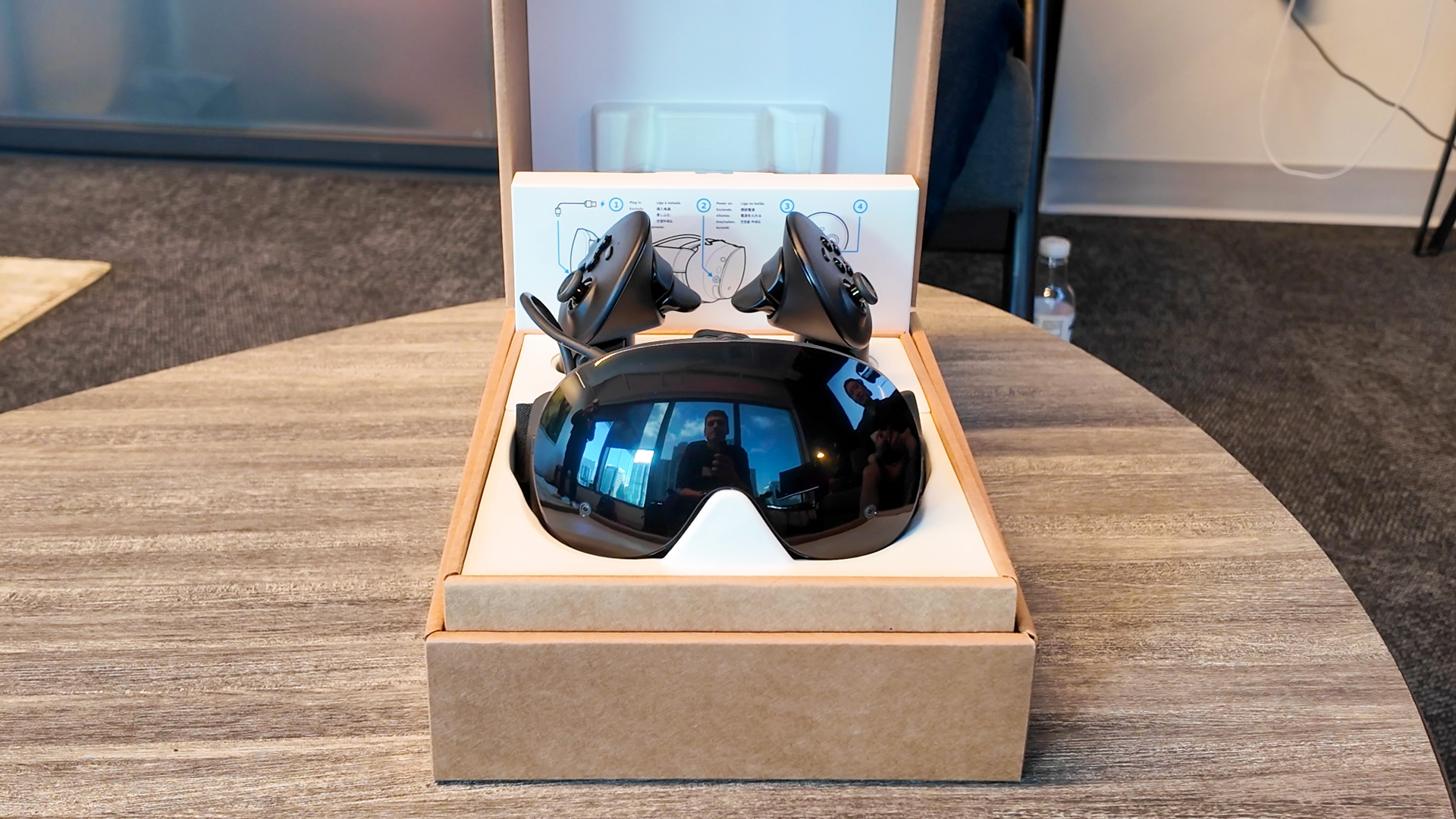
The Steam Frame will be available in all the same regions where the Steam Deck is currently available, including those where Komodo is the official distributor. That means it's set to launch in the following countries:
- USA
- Canada
- UK
- Germany
- France
- Australia*
- Japan**
- South Korea**
- Taiwan**
- Hong Kong**
*Valve began shipping direct to Australia later than other countries
**Distributed by Komodo

The best PC gaming gear 2025
All our current recommendations











Jacob earned his first byline writing for his own tech blog, before graduating into breaking things professionally at PCGamesN. Now he's managing editor of the hardware team at PC Gamer, and you'll usually find him testing the latest components or building a gaming PC.
You must confirm your public display name before commenting
Please logout and then login again, you will then be prompted to enter your display name.
